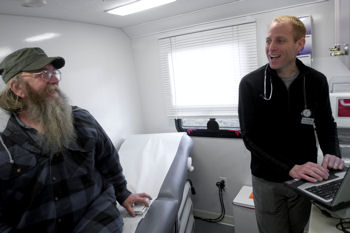Diabetes project narrows gap between theory and practice
Following a successful first phase, the College's diabetes programs reach out to a wider audience of members, residents and patients.
The three-year Diabetes Initiative of the College and the ACP Foundation, funded by an unrestricted educational grant from Novo Nordisk, is promoting a team approach to care that encourages patients to take control of their own health. The new approach has led to patients seeing their doctors more often, getting tests more frequently and improving clinical outcomes—and now the program's expanding to reach more internists.
“[Results] went far beyond my expectations,” said ACP Director of Clinical Programs Vincenza Snow, FACP, who led the initiative.
As part of the initiative, a quality improvement project recruited 20 practices to participate in an intensive effort to close the gap between evidence and practice in diabetes care. The Closing the Gap project began by collecting data on the practices' diabetes-related procedures and patients. Then three representatives of each practice, a physician, the office manager and a nurse or other allied health professional, attended hands-on training sessions.
Given the short time frame of the project (practices' before and after measurements were taken only six months apart), Dr. Snow said she was pleased to see many process changes, especially an average decrease in days since the patient's last visit for diabetes care from 115 days to 58 days. “That's a huge difference. The whole point of the program is planned care and having people come in for diabetes-specific visits, not when they have a cold or a back problem.”
By the end of the study, patients were also getting more frequent checks of their blood pressure, HbA1c levels, lipids and urine albumin. There were also measurable and significant improvements in some of the study's outcome measures, particularly cholesterol levels. After the project, patients had lower average LDL (from 97.5 to 92.7) and lower total cholesterol levels (from 180 to 171).
“It's not surprising that we saw the biggest differences in lipid levels. Once you start targeting it and treating it well, you see differences in outcomes,” said Dr. Snow. The other improved processes, such as more frequent blood pressure and A1c measurement, should also lead to better outcomes, but in a longer time frame, she added.
One less tangible measure of the project's success was the change in the real-life working relationships among the physicians and their staffs, Dr. Snow said. “You would see the lights going on as they were talking to each other. The doctor would say, ‘Wouldn't it be nice if we could do x, but I don't think we can.’ The office manager says, ‘Yes, we can.’ They had never had a chance to talk about these things.”
Teamwork includes patients
In addition to fostering teamwork inside the practices, the initiative also aimed to get patients more involved in their treatment. A survey conducted on ACPNet, the College's practice-based research network, as part of the Diabetes Initiative found that physicians' top frustrations with treating diabetes were patients' non-compliance, lack of motivation and limited health literacy.
“The need for patient self-management education is really, really coming out loud and clear,” said Dr. Snow. “We already know that doctors don't do a very good job of patient education. Patient self-management is even more complex. It goes beyond telling a patient that she has diabetes and needs to take medication to lower her blood sugar level.”
What patients needed were specific explanations of the lifestyle and medication interventions required to manage their diabetes, the initiative experts concluded. To fill that need, the ACP Foundation produced, as another component of the initiative, a patient guide, Living with Diabetes, which includes photos and easy-to-read text on the specifics of diet, exercise and medication. “It's like a script to go through with patients,” said Dr. Snow.
The patient guide also serves when no one has time to give patients a more complete explanation of the disease. Pamela J. Myhre, a registered nurse and certified diabetes educator, is involved in a project in Wisconsin that has distributed the guide to newly diagnosed patients who would otherwise have to wait weeks for an educator to teach themself-management.
“We wanted them to have something in their hand within the first days of their diagnosis of diabetes so their education begins in the primary care provider's office,’” said Ms. Myrhe.
The patients in her project received some of the 600,000 copies of Living with Diabetes that have been distributed in the past year. The overwhelming response led to its reprinting for phase II of the Diabetes Initiative.
Success breeds success
Phase I of the project, which also included the launch of the ACP diabetes Web portal, a diabetes track at the past three annual meetings, and a multi-specialty conference on improving transitions of care, wrapped up in December 2007. There were measurable improvements seen in all programs of the initiative, Dr. Snow said.
Attendance at the diabetes track went from 3000 attendees at 13 sessions in 2005 to 4300 at 23 sessions in 2007. The Diabetes Portal has received over 1.5 million page hits, averaging around 72,000 a week, with the most popular downloads being tools for improving direct patient care.
Based on the success of the first phase, Novo Nordisk signed on with another grant, and the second phase is already underway. The focus this time around is on getting the information about best practices in diabetes treatment out to resident physicians in training.
“The future holds a lot of promise for educating younger clinicians in training. They will learn how to do it right the first time,” said Doron Schneider, ACP Member, who serves on the initiative's advisory board.
As part of phase II, 26,000 internal medicine residents will receive copies of the ACP Diabetes Care Guide, another publication of the Diabetes Initiative. The guide takes the team-based, chronic care philosophy of the initiative and applies it as a practice manual and self-assessment education program.
Since the guide's first printing last April, more than 84,000 copies have been distributed and put into practice. Both the ACP Diabetes Care Guide and the Living with Diabetes patient guide can be ordered through the College's Diabetes portal.
Practicing physicians will also have their chance to get involved in the project. ACP staff is currently recruiting 1,000 practices to participate in a new Closing the Gap program, with one big difference–the entire project will be conducted by Internet and conference call. The program will still offer CME and re-certification credit, but education will be provided online for participants to complete at their own pace, with occasional conference calls between participating practices and expert faculty.
“I think there's still a role for the more intensive program, but if we're going to give a large majority of our membership the opportunity to change their practice we need to pilot this model,” said Dr. Snow.
Physicians interested in participating in ACP's diabetes programs should visit the Closing the Gap Web site or contact Lia Verbonitz at 800-227-1915, ext. 2602.





